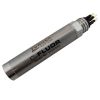Turner Designs DataBank Handheld Data Logger
Features
- Stores up to 9,999 records and 16 calibrations
- Simplifies sensor calibration & includes auto-gain function
- Now includes integrated GPS standard with the purchase
- Free ground shipping
- Expedited repair and warranty service
- Lifetime technical support
- More
Overview
The Turner Designs DataBank is a universal meter, data logger, & power supply. Data can be stored and downloaded to a PC. Sensor calibration is simplified through continuous sensor readings with results graphically displayed. Sensor power is provided directly from the DataBank, which is powered by internal rechargeable batteries, an external 9-30VDC power source, or AC power.
GPS Data
GPS data are integrated into the DataBank. Each line of data that is stored or exported contains time, date, and position information, as well as the sample measurement. The Turner Designs DataBank is ideal for conducting dye trace studies, mapping algal blooms or looking for the presence of optical brighteners as an indicator of wastewater contamination.
- (1) DataBank data logger with rechargeable NiMH batteries
- (1) PC/Power USB interface cable
- (1) AC to DC charger supply
- (1) USB Drive with Software
In The News
Combating Water Insecurity in Saskatchewan with Real-Time Data
The prairies of Saskatchewan can be described as one of the least water-secure parts of Canada, making water quality monitoring essential for informed resource management in a region already facing water insecurity. While natural physical properties worsen some of the poor water quality conditions in the region, others are connected to land use. Having grown up spending summers on the shores of Lake Huron, Helen Baulch, an associate professor at the School of Environment and Sustainability at the University of Saskatchewan , has always been dedicated to the protection of water resources. Looking back fondly at her childhood playing along the shore, Baulch also recalls the invasion of quagga mussels during her teenage years and watching the lake change as a result.
Read MoreSeametrics Turbo Turbidity Logger: Boost your Turbidity Monitoring
The Seametrics Turbo Turbidity Logger is a self-cleaning turbidity sensor capable of internally logging over 260,000 data records. The sensor enables researchers, compliance officers, and contractors to monitor turbidity in various applications, from construction and dredging sites to wastewater effluent. Due to its narrow width, this device can be deployed in a range of areas, from small well spaces to rivers and streams. The stainless steel housing and built-in wiper allow the sensor to withstand long-term deployments and reduce the need for maintenance trips. The logger accurately records temperature and turbidity up to a depth of 50 meters.
Read MoreCollecting Data at the Top of the World: How Scientists Retrieve Glacial Ice Cores
A helicopter touches down in the small town of Sicuani, Peru, at an elevation of 11,644 feet. Earlier that day, a boxcar brought fuel, drills, food, and other equipment for a glacial expedition. The year is 1979, and glaciologist Lonnie Thompson is preparing to lead a team to the Quelccaya ice cap in hopes of becoming the first scientists to drill an ice core sample from this glacier. The only problem? The glacier is located at 19,000 feet in one of the most remote areas of the world. The helicopter takes off from the town, but the thin atmosphere at that elevation does not allow it to safely touch down on the ice– due to the aircraft’s weight, and it becomes unstable when the air is less dense.
Read More





























